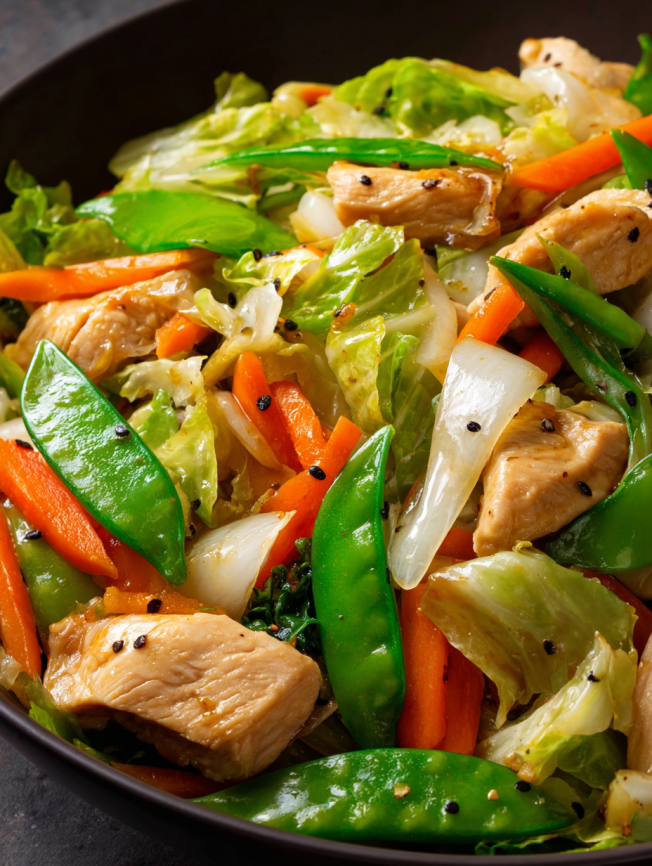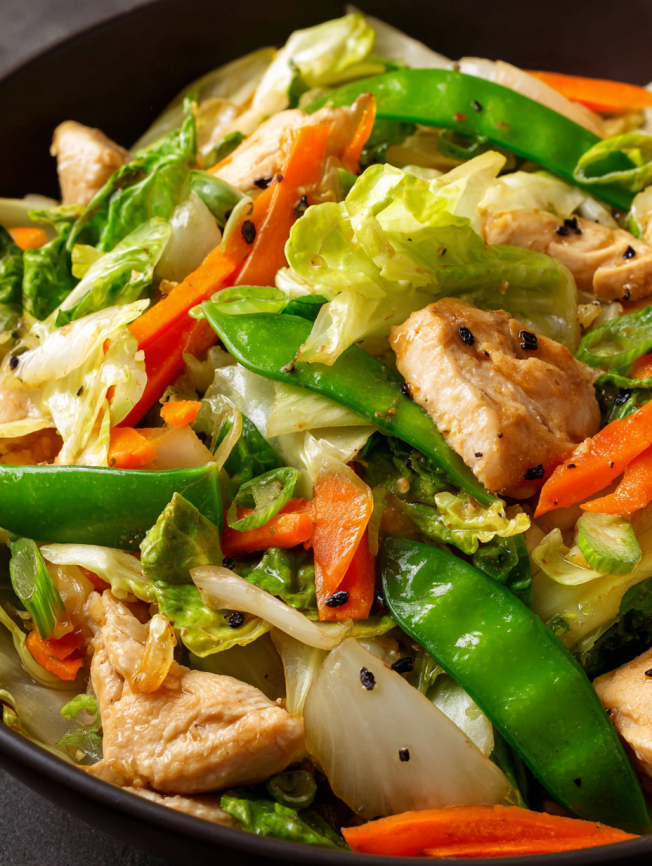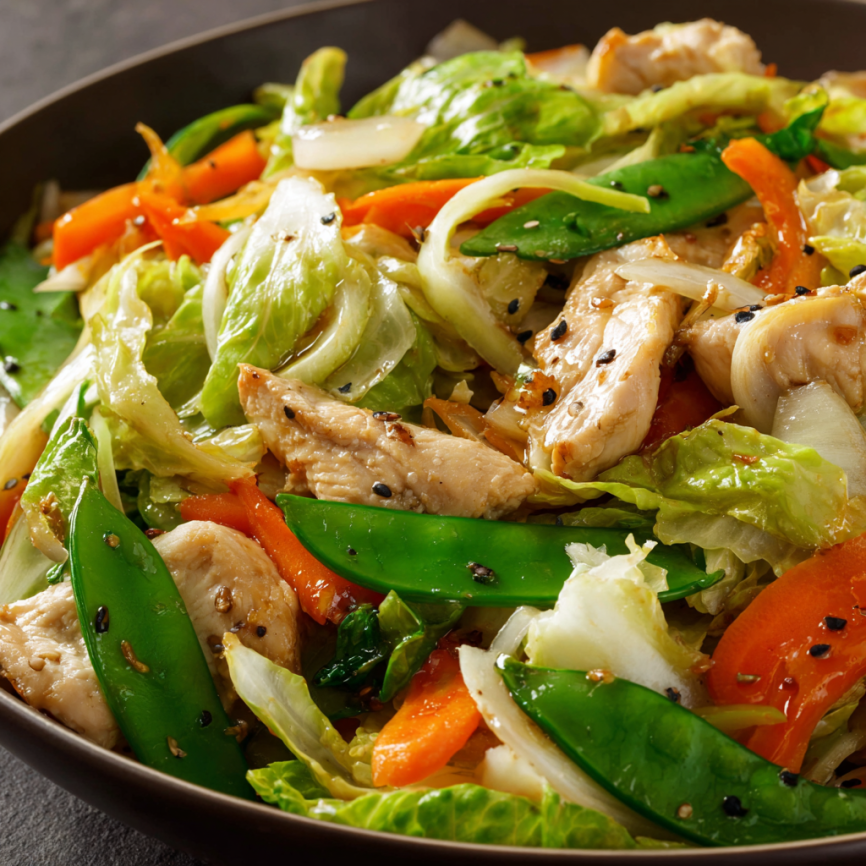After spending a semester studying abroad in Beijing, I returned home with a deep appreciation for authentic Chinese stir-fry techniques and an insatiable craving for simple, fresh flavors. This Chinese Chicken Cabbage Stir Fry became my way of recreating those memorable street food experiences in my own kitchen. What started as homesickness remedy quickly evolved into my family’s favorite weeknight dinner solution.
The magic of this dish lies in its perfect balance of simplicity and sophistication. While the ingredient list appears basic, the combination of tender marinated chicken, crisp cabbage, and aromatic garlic creates layers of flavor that satisfy both comfort food cravings and healthy eating goals. Moreover, the entire meal comes together in just 30 minutes, making it ideal for those hectic evenings when time is precious but good food remains non-negotiable.
Why This Stir Fry Will Transform Your Dinner Routine
Lightning-Fast Preparation
Unlike elaborate dishes that chain you to the kitchen for hours, this stir fry delivers restaurant-quality results in just 30 minutes. The marinating time overlaps perfectly with vegetable prep, maximizing efficiency without sacrificing flavor development.
Nutritional Powerhouse
This recipe packs impressive nutritional value into every bite, featuring lean protein, fiber-rich vegetables, and minimal added fats. Additionally, cabbage provides essential vitamins and antioxidants while keeping the calorie count surprisingly low.
Budget-Friendly Excellence
Creating delicious meals doesn’t require expensive ingredients, and this recipe proves that point beautifully. Basic pantry staples and affordable vegetables combine to deliver satisfying portions that feed a family without breaking the budget.
Versatile Foundation
Whether you’re following specific dietary requirements or simply want variety, this recipe adapts easily to different preferences. Swap vegetables, adjust spice levels, or modify the protein to create countless variations using the same fundamental technique.
Essential Ingredients Collection
Chicken Marinade Components:
- 1 lb boneless, skinless chicken breast, thinly sliced
- 1 tablespoon low-sodium soy sauce
- 1 teaspoon cornstarch
- ½ teaspoon sesame oil
- ¼ teaspoon black pepper
Fresh Stir Fry Elements:
- 1½ tablespoons vegetable oil (divided)
- 3 cups green cabbage, thinly sliced
- 1 medium carrot, julienned (optional)
- 2 green onions, chopped
- 2 garlic cloves, minced
- 1 teaspoon fresh ginger, grated
Flavorful Sauce Mixture:
- 2 tablespoons soy sauce (low-sodium preferred)
- 1 tablespoon oyster sauce
- 1 teaspoon rice vinegar
- ½ teaspoon sugar (optional)
- 2 tablespoons water
Step-by-Step Cooking Guide
Preparation Phase
Step 1: Marinate for Maximum Flavor Combine sliced chicken with soy sauce, cornstarch, sesame oil, and black pepper in a medium bowl. Mix thoroughly to ensure every piece is well-coated, then set aside for 10-15 minutes. This marinating time allows the cornstarch to create a protective coating that keeps the chicken tender during high-heat cooking.
Step 2: Create the Sauce Base While the chicken marinates, whisk together all sauce ingredients in a small bowl until the sugar dissolves completely. Having the sauce ready before cooking begins prevents burning and ensures even flavor distribution throughout the dish.
High-Heat Cooking Process
Step 3: Achieve Perfect Chicken Texture Heat 1 tablespoon of oil in a wok or large skillet over medium-high heat until it shimmers but doesn’t smoke. Add marinated chicken in a single layer, avoiding overcrowding which leads to steaming rather than searing. Stir-fry for 4-5 minutes until the chicken develops light golden edges and reaches 165°F internal temperature.
Step 4: Remove and Rest Transfer the cooked chicken to a clean plate and set aside. This temporary removal prevents overcooking while the vegetables cook, ensuring the final dish features perfectly tender protein rather than tough, rubbery pieces.
Vegetable Preparation
Step 5: Build Aromatic Foundation Add the remaining oil to the same wok, allowing it to heat for 30 seconds. Next, add minced garlic and grated ginger, stir-frying for just 30 seconds until fragrant but not browned. This brief cooking time releases essential oils without creating bitter flavors.
Step 6: Master the Vegetable Timing Add sliced cabbage and julienned carrots to the aromatic oil, stirring constantly for 3-4 minutes. The vegetables should maintain slight crispness while becoming bright and tender. Finally, incorporate chopped green onions and stir for one additional minute to preserve their fresh bite.
Final Assembly
Step 7: Combine and Finish Return the cooked chicken to the wok, immediately followed by the prepared sauce. Toss everything together vigorously for 1-2 minutes, allowing the sauce to coat all ingredients evenly while thickening slightly from the residual heat.
Step 8: Serve Immediately Transfer the stir fry to serving plates while still steaming hot. Timing is crucial for stir-fry success – serving immediately ensures vegetables retain their crisp texture and vibrant colors.

Creative Serving Suggestions
Traditional Presentations
Serve generous portions over steamed jasmine rice for a classic combination that absorbs the flavorful sauce beautifully. Alternatively, try it over brown rice for added fiber and nutrition, or cauliflower rice for a low-carb option that doesn’t compromise on satisfaction.
Noodle Variations
Transform this dish by serving over cooked lo mein noodles, rice noodles, or even spiralized zucchini for a vegetable-forward presentation. Each base creates a different dining experience while maintaining the core flavors.
Light and Fresh Options
For those seeking lighter fare, serve the stir fry on its own as a complete meal, garnished with sesame seeds and fresh cilantro. This presentation highlights the vegetables’ natural flavors while providing satisfying protein content.
Delicious Recipe Variations
Spicy Sichuan Style
Elevate the heat level by adding 1-2 teaspoons of chili garlic sauce to the marinade and sprinkling red pepper flakes over the finished dish. This variation creates tingling warmth that complements the fresh cabbage beautifully.
Colorful Vegetable Medley
Expand the vegetable selection by including bell peppers, snap peas, or broccoli florets alongside the cabbage. These additions provide extra nutrients and create a more visually appealing presentation without significantly changing cooking times.
Protein Alternatives
Substitute chicken with thinly sliced beef, pork, or even firm tofu for vegetarian preferences. Each protein requires slightly different cooking times, but the fundamental technique remains the same for consistent results.
Nutty Crunch Addition
Incorporate chopped cashews, almonds, or peanuts during the final tossing stage for added texture and richness. These nuts provide healthy fats and create satisfying contrast against the tender vegetables.
Make-Ahead Tips and Storage
Preparation Strategies
Marinate the chicken and prepare all vegetables up to 24 hours in advance, storing them in separate containers in the refrigerator. Having everything ready transforms this quick meal into an almost instant dinner option.
Sauce Preparation
Mix the stir-fry sauce up to one week ahead and store it in the refrigerator in an airtight container. This advance preparation saves precious time during busy weeknights and ensures consistent flavor development.
Leftover Management
Store cooked stir fry in the refrigerator for up to three days, though the vegetables will soften slightly upon reheating. Reheat gently in a skillet over medium heat rather than the microwave to maintain the best possible texture.
Batch Cooking Benefits
Double the recipe and portion leftovers into individual containers for healthy lunch options throughout the week. The flavors actually improve after resting overnight, making this an excellent meal prep candidate.
Important Cooking Notes
Chicken Slicing Technique: Cut chicken against the grain in thin, uniform slices for the most tender results. Partially freezing the chicken for 15-20 minutes makes slicing much easier and more precise.
Oil Temperature Management: Proper oil temperature prevents sticking while ensuring quick cooking. The oil should shimmer and move freely in the pan but never smoke, which indicates temperatures that are too high.
Wok Hei Achievement: The coveted “breath of the wok” flavor comes from high heat and quick cooking. Don’t reduce the heat if ingredients seem to cook quickly – this rapid cooking creates the characteristic stir-fry taste.
Vegetable Texture Balance: Cabbage should retain some crunch even when fully cooked. Overcooked cabbage becomes mushy and loses its appealing texture contrast against the tender chicken.
Sauce Consistency: The sauce should lightly coat ingredients without pooling in the bottom of the pan. If it seems too thick, add water one tablespoon at a time until reaching the desired consistency.

Frequently Asked Questions
Q: Can I use pre-cut coleslaw mix instead of fresh cabbage? A: Yes, bagged coleslaw mix works perfectly and saves preparation time. However, it may cook slightly faster than fresh-cut cabbage, so reduce the cooking time by 1-2 minutes to maintain proper texture.
Q: What’s the best way to achieve restaurant-style “wok hei” flavor at home? A: Use the highest heat your stove allows, cook in small batches to avoid overcrowding, and keep ingredients moving constantly. A well-seasoned carbon steel or cast iron pan provides better results than non-stick surfaces for achieving that characteristic smoky flavor.
Q: Can I make this dish without oyster sauce? A: Absolutely! Substitute with an additional tablespoon of soy sauce plus a teaspoon of sugar, or use mushroom sauce for umami depth. Hoisin sauce also works well, though it will create a slightly sweeter flavor profile.
Q: How do I prevent the chicken from becoming tough? A: Proper marinating, thin slicing against the grain, and avoiding overcooking are key. The cornstarch in the marinade creates a protective coating that helps maintain tenderness during high-heat cooking.
Q: What vegetables can I substitute for cabbage? A: Bok choy, napa cabbage, broccoli, or snow peas all work wonderfully. Just adjust cooking times accordingly – leafy greens cook much faster than dense vegetables like broccoli or carrots.
Q: Is this recipe suitable for meal prep? A: Yes, though the vegetables will soften slightly when reheated. For best results, slightly undercook the vegetables initially and store the sauce separately, combining everything when reheating for fresher texture and flavor.
Prep Time: 15 minutes
Cook Time: 15 minutes
Total Time: 30 minutes
Servings: 4
Cuisine: Chinese/Asian Fusion
This Chinese Chicken Cabbage Stir Fry proves that exceptional meals don’t require complicated techniques or exotic ingredients. With basic pantry staples and fresh vegetables, you can create satisfying dinners that rival your favorite takeout while knowing exactly what goes into every delicious bite.

